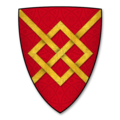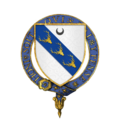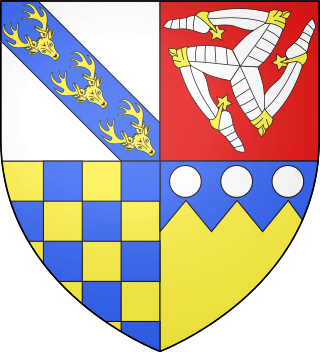
Thomas Stanley, 1st Earl of Derby, KG was an English nobleman. He was the stepfather of King Henry VII of England. He was the eldest son of Thomas Stanley, 1st Baron Stanley and Joan Goushill.

Earl of Derby is a title in the Peerage of England. The title was first adopted by Robert de Ferrers, 1st Earl of Derby, under a creation of 1139. It continued with the Ferrers family until the 6th Earl forfeited his property toward the end of the reign of Henry III and died in 1279. Most of the Ferrers property and the Derby title were then held by the family of Henry III. The title merged in the Crown upon Henry IV's accession to the throne in 1399.

Baron Audley is a title in the Peerage of England first created in 1313, by writ to the Parliament of England, for Sir Nicholas Audley of Heighley Castle, a member of the Anglo-Norman Audley family of Staffordshire.

Baron Strange is a title which has been created four times in the Peerage of England. Two creations, one in 1295 and another in 1326, had only one holder each, upon whose deaths they became extinct. Two of the creations, that of 1299 and that of 1628, are extant. The surname Le Strange was Latinized as Extraneus. The arms of Le Strange of Knockin Castle in Shropshire were: Gules, two lions passant argent.

James Tuchet, 5th Baron Audley, 2nd Baron Tuchet of Heleigh Castle was an English peer.
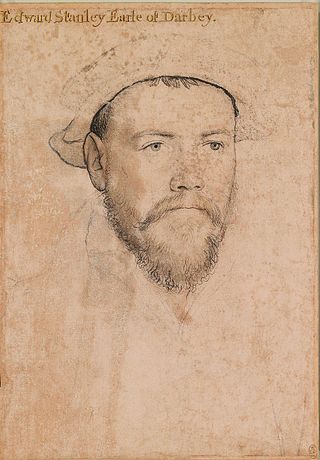
Edward Stanley, 3rd Earl of Derby KG was an English nobleman and politician. He succeeded his father as Lord of Mann until his death, and then was succeeded by his son.
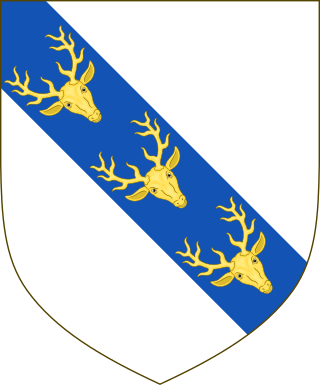
Sir John Stanley, KG of Lathom, near Ormskirk in Lancashire, was Lord Lieutenant of Ireland and titular King of Mann, the first of that name. He married a wealthy heiress, Isabel Lathom, which, combined with his own great abilities, allowed him to rise above the usual status of a younger son.

Sir James Audley, KG was one of the original knights, or founders, of the Order of the Garter. He was the eldest son of Sir James Audley of Audley in Staffordshire.

James Stanley, 7th Earl of Derby, KG was an English nobleman, politician, and supporter of the Royalist cause in the English Civil War. Before inheriting the title in 1642 he was known as Lord Strange. He was feudal Lord of the Isle of Man, where he was known as "Yn Stanlagh Mooar".

Henry Stafford, 1st Baron Stafford was an English nobleman. After the execution for treason in 1521 and posthumous attainder of his father Edward Stafford, 3rd Duke of Buckingham, with the forfeiture of all the family's estates and titles, he managed to regain some of his family's position and was created Baron Stafford in 1547. However his family never truly recovered from the blow and thenceforward gradually declined into obscurity, with his descendant the 6th Baron being requested by King Charles I in 1639 to surrender the barony on account of his poverty.

Charlotte Stanley, Countess of Derby, born Charlotte de La Trémoille, is famous for her robust defence of Lathom House during the English Civil War.

Lathom House was a large country house in the parish of Lathom in Lancashire, England. Built between 1725 and 1740, the main block was demolished in 1925.

Sir Thomas Stanley, 1st Baron Stanley, titular King of Mann, KG, of Lathom and Knowsley, Lancashire, was a Privy Councillor, Comptroller of the Royal Household, Lieutenant-Governor of Ireland (1431–36), Chief Steward of the Duchy of Lancaster, Knight of the Shire for Lancashire, Constable & Justice of Chester, Chamberlain of North Wales, Lord Chamberlain (1455), and from 15 January 1456 was summoned by Writ to Parliament as Lord Stanley.

Nicholas Audley, 3rd Baron Audley was born at Heighley Castle, Staffordshire, England to James Audley, 2nd Baron Audley, and was his only surviving son.

James Audley, 2nd Baron Audley of Heighley Castle, Staffordshire, was an English peer. He was the son and heir of Nicholas Audley, 1st Baron Audley (1289–1316) by his wife Joan Martin, who was the daughter of William Martin, feudal baron of Barnstaple, and Marcher Lord of Kemes. She was posthumously the eventual sole heiress of her brother William FitzMartin to Barnstaple and Kemes.

Alice Spencer, Countess of Derby was an English noblewoman from the Spencer family and noted patron of the arts. Poet Edmund Spenser represented her as "Amaryllis" in his eclogue Colin Clouts Come Home Againe (1595) and dedicated his poem The Teares of the Muses (1591) to her.

John Tuchet, 6th Baron Audley, 3rd Baron Tuchet was an English politician.

From AD 1066, the feudal barony of Barnstaple was a large feudal barony with its caput at the town of Barnstaple in north Devon, England. It was one of eight feudal baronies in Devonshire which existed in the Middle Ages. In 1236 it comprised 56 knight's fees or individual member manors. The feudal service owed for half the barony in 1274 was the provision to the royal army of two knights or four sergeants for forty days per annum, later commuted to scutage.
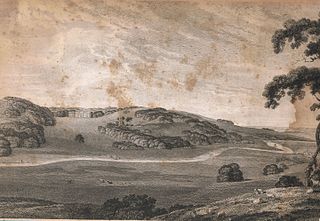
The historic manor of Tawstock was situated in North Devon, in the hundred of Fremington, 2 miles south of Barnstaple, England. According to Pole the feudal baron of Barnstaple Henry de Tracy made Tawstock his seat, apparently having abandoned Barnstaple Castle as the chief residence of the barony. Many of the historic lords of the manor are commemorated by monuments in St Peter's Church, the parish church of Tawstock which in the opinion of Pevsner contains "the best collection in the county apart from those in the cathedral", and in the opinion of Hoskins "contains the finest collection of monuments in Devon and one of the most notable in England".
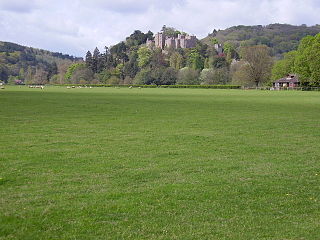
The feudal barony of Dunster was an English feudal barony with its caput at Dunster Castle in Somerset. During the reign of King Henry I (1100–1135) the barony comprised forty knight's fees and was later enlarged. In about 1150 the manors retained in demesne were Dunster, Minehead, Cutcombe, Kilton and Carhampton in Somerset, and Ham in Dorset.






